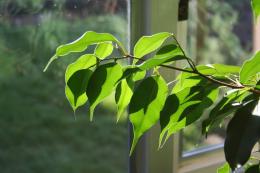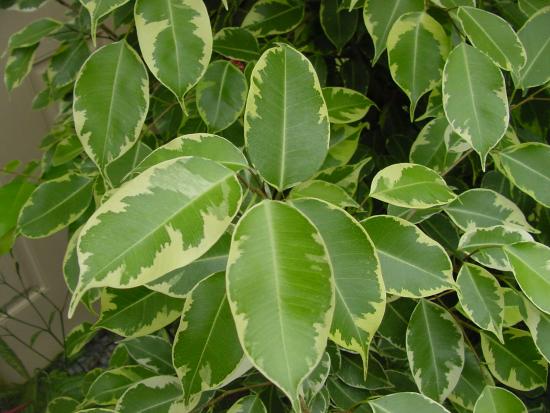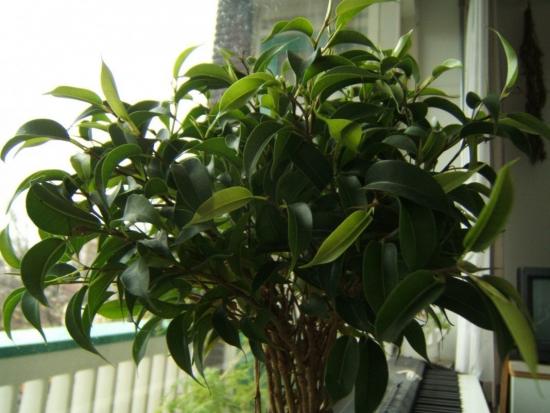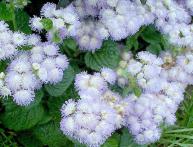How to propagate Ficus Benjamin at home, caring for a young plant

Ficus benjamina is one of the popular plants for landscaping residential and office premises. This is due to its attractive appearance, unpretentiousness, rapid growth and ability to purify the air. Let's try to find out how multiply ficus benjamina at home and properly organize its care.
Content:
Basic methods of propagating ficus
Ficus benjamina came into indoor floriculture, most likely from China or other Asian countries. In the wild, it is found in India, Australia, Africa and the Philippine Islands. The plant has a developed root system, straight strong stems and beautiful shiny leaves.
This type of ficus can be propagated by seeds and cloning for industrial purposes.
Since ficus benjamina blooms extremely rarely indoors, it is almost impossible to obtain seeds from it. Therefore, the seed propagation method is used only for breeding and scientific purposes. Cloning, that is, growing a plant from one cell, is possible only in the laboratory.
At home, Ficus Benjamin can be propagated by vegetative methods:
- stem cuttings
- apical cuttings
Despite the fact that cuttings are harvested from different parts of the stem, their rooting and further cultivation are fundamentally no different.
Preparation and rooting of cuttings
The best time to propagate Ficus Benjamin is spring. To obtain planting material, you need an adult, healthy plant. The propagation procedure can be timed to coincide with transplanting into a new pot or pruning. Use a clean, sharp knife to cut off the top of the shoot. 12 - 15 cm long. The cut can be made oblique or straight.
Important! You cannot use scissors to obtain a cutting, as damage to the tissue of the cutting may occur between the blades. White, quickly drying juice will appear at the cut site. Its influx will delay the formation of roots. Therefore, the juice must be washed off under running water until the discharge stops.
Also for these purposes, the tips of the petioles can be kept in warm water and then washed. After this, you need to let the sections air dry. If there are several leaves on the cutting, then half of them need to be removed. Then you can start rooting.
Rooting in water
In order for rooting in water to be successful, it is advisable to use dark, opaque dishes, for example, a ceramic pot. A small amount of root former added to the water will speed up the process. A few shallow scratches at the bottom of the cutting will shorten the time it takes for roots to emerge. At about 4-5 weeks, roots will begin to appear. When their length is 1-2 cm, the plant can be transplant in a pot.
Rooting in the ground

The soil mixture for rooting cuttings can be made up of equal parts of sand, peat and perlite. A few hours before planting the cuttings, the soil is well moistened. The cutting needs to be buried in the ground by about 1/3 of its length. Cover the container with the cutting with a bag or part of a plastic bottle. From time to time the substrate needs to be moistened.
The appearance of new leaves will confirm successful rooting. After this, the seedling can be gradually hardened off by removing the cover for a while, and then transplanting the cutting into a pot. Transplanting a cutting with roots into a permanent pot, care after transplantation
Transplanting cuttings with roots into the ground
To transplant a cutting, you should not take a pot that is too large in volume. This will slow down the establishment and growth of the ficus. Place a 3-4 cm layer of drainage at the bottom of the pot. Broken bricks and fine expanded clay gravel will do. Land can be purchased ready-made, intended for ficus. For a young plant, you can independently make a mixture of equal parts:
- leaf soil
- peat
- sand
All parts soil must be steamed in the oven or otherwise disinfected. Fill the pot with the resulting mixture and water everything well the day before transplanting the young ficus. In moist soil, make a hole the size of the roots. Plant the seedling and cover the roots with soil mixture.

Lightly compact everything. Important! The roots of Ficus Benjamin are quite fragile, so transplantation is carried out very carefully so as not to break them. Place the pot in a place well lit with diffused light. The room should be sufficiently humid and warm. After three days, the transplanted ficus can be watered for the first time.
Caring for young ficus
The frequency of watering Ficus Benjamin is determined by the drying of the earthen clod. As soon as it has dried to a depth of three cm, you can water it again. In winter, the drying depth may be greater and watering may be less frequent. Water for irrigation should be warm.
After watering, the plant can be fed with any fertilizer for indoor flowers. From spring to autumn, feed the plant every 15 days.The optimal indoor temperature for growing ficus in summer should be between + 18 + 25 degrees. In winter from + 18 to + 20 degrees. In dry air conditions, the plant needs to be sprayed or a bowl of water placed next to the pot.
Important! Can't hold ficus at temperatures below 10 degrees. As the plant masters the pot, it needs to be transplanted into a new one, 2-3 cm larger in volume. If the cultivation of a young seedling is organized correctly, then after a couple of years the ficus will become an interior decoration.
Video about proper propagation of ficus:











Comments
I have many varieties of ficus, including Benjamin. The flower is unpretentious and I usually propagate it from cuttings. It grows quickly and pleases me with its abundant greenery.
I really like this plant. Over the course of several years, a tree grew that I decided to sell. I left a small cutting for myself. I didn’t put it in water, I immediately planted it in the ground and covered it with a glass jar. After three weeks the cutting took root. Now I have a new ficus Benjamin bush growing.
I have two Benjamin ficuses - one with green leaves, the other with marble leaves. Rooting the second one was not very easy; it stood in water for a long time without producing roots, and planting it straight into the soil did not produce results even after a month.